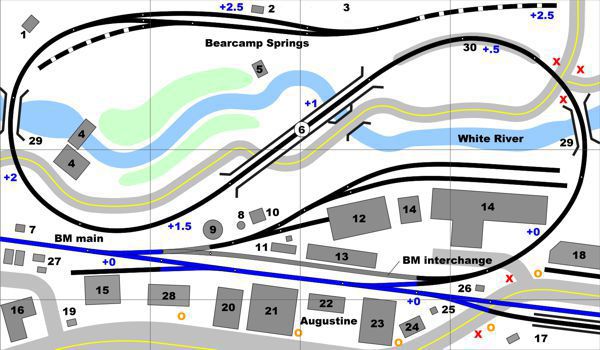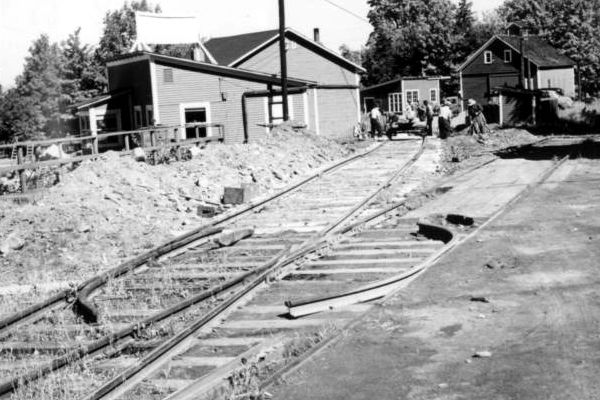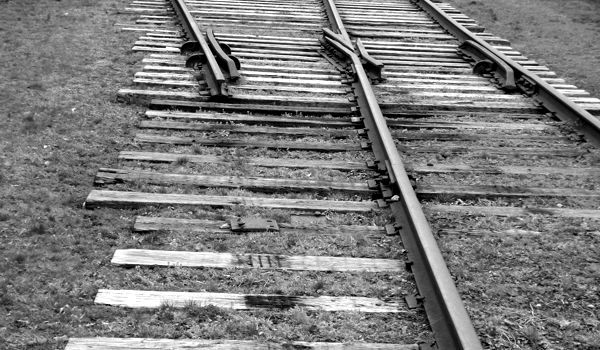11. Something I Had To Do
Back in June 2020, I'd contemplated dropping the whole springwater hauling shtick, and switching over to tourist-hauling. By 27 July 2020, I'd pretty much talked myself into it. One reason for doing this is it would be more in keeping with reality, since to my knowledge there was never a springwater-hauling railroad in New Hampshire, whereas there were/are a number of tourist railroads, at least one of which was established in the early 1950s (the layout's temporal setting). On the downside, it meant making changes to the track plan, as a runaround at Bearcamp Springs would dispense with the train having to awkwardly back down the hill. Also, I'd have to rework the Bearcamp Springs Resort as refurbished instead of abandoned (trivial in the grand scheme of things).
Anyway, with respect to the track plan changes, I'd have to replace the left curved turnout at the former tank car loading siding (curiously having already been relocated there) with two right curved turnouts to make a runaround. Below is the revised plan; note the runaround is just barely long enough for a trio of Overton passenger cars, which is all that's needed. The siding near the old spring house will be modeled as disused, simulating a relic of the branchline in its early logging or mining days.

The first step was to remove the entire uppermost level, starting from where the first new turnout would go (below, far right).

Fortunately I just happened to have a leftover piece of Gatorfoam large enough to replace the entire uppermost level.

After I cut the Gatorfoam to shape and sketched out the track routes (above), I applied double-stick tape where the track was going (below).

All the while I was working up the courage to lay the turnouts myself—after all, I was making micro-mechanisms for animated scenes, so why couldn't I hand-lay them? More than likely they wouldn't be as pretty as the ones made for me, but since they're at the back of the layout, they didn't need to look perfect; they only had to work.

After I installed the new upper level piece on the layout (above), I prepared to build the turnouts in situ by laying flex track, and removing ties from the ends to leave enough free rail for the turnouts (below). It's somewhat wasteful of flex, but I had loads to spare.

To save a substantial amount of time and effort, I made use of some Micro Engineering Code 55 turnout parts sets (#80-332) I had on hand, which include frogs, points and guardrails; I just used the frogs. This meant I'd have no rail filing, grinding or shaping to do.

All I had to do was solder wires to the frogs, then "install" them by heating them with a soldering iron so they'd sink into the styrene ties far enough to make up the 0.015" height difference between them and the Code 40 rail.

After all of the components were in place, I saturated the entire turnout with CA, as some of the ties weren't fully secured to the double-stick tape owing to dirt accumulation.

The second stub switch (above) went together in a fraction of the time it took to make the first, as one might expect. With the completion of the disused siding turnout on 2 August 2020 (below), the layout revisions were done. All that's left to do is install the turnout controls.

On 3 August 2020 I completed the revision cosmetically by painting all of the new track.

The story didn't end there, however. As I subsequently discovered, adding the runaround left no room for the Bearcamp Springs Resort—which I corrected during Hurricane Isaias.
Control
Originally the turnouts were to be operated manually, just as the rest are. However, after installing the firefly field, mill spillway and mill water wheel, I lost the space needed to run a control rod from the front to the back of the layout. Therefore, the turnouts will be powered. My plan is to drive them both with the same motorized unit.
Reference
In spite of the fact that they'd be difficult to see, I elected to make stub switches, which are fascinating and rare railroad relics. For one thing, stub switches are much easier to build, and for another, as models they're more reliable than traditional point-style switches: tapered points are a pain to make, and wheels tend to pick at them. The first example is on the White Mountain Central; note the traditional harp switch stand.


I also decided to make the wacky-looking guard rails seen in some reference images.

And the look of the disused turnout was inspired by this:

